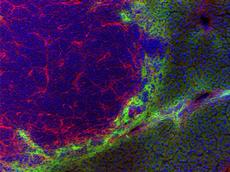Starving cancer
A research group led by ETH Zurich professor Dario Neri have developed a new strategy to fight cancer. Blood vessels in the environment of tumours are killed with a new molecule which leads to the „starvation” of the tumour. Compared to currently applied treatments, this new strategy has a series of advantages.

Modern cancer therapeutics produced by biotechnological methods, often are based on antibodies. „Commonly these antibodies are used unmodified, which is – with a few exceptions – not very efficient though”, says Dario Neri, Professor of Biomacromolecules at the Institute of Pharmaceutical Sciences of ETH Zurich. For this reason, an important trend in the development of new chemotherapeutics is to „arm” the antibodies, for example by coupling them to a cytotoxic drug, in order to increase their efficacy.
The ETH researchers under the supervision of Prof. Neri developed such an antibody in collaboration with Philochem, a spin-off company of ETH Zurich. They experimentally showed that cancer bearing mice survived twice as long as without treatment. The researchers published their work in the journal „Angewandte Chemie International Edition”.
Lesser risk of resistances
Prof. Neri’s promising strategy differs from other armed antibodies currently in development with respect to several points. The macromolecules of the ETH researchers are not directed towards the cancer cells themselves but towards newly formed blood vessels within the surroundings of the tumour. This blocks the delivery of nutrients to the tumour and inhibits its growth. This strategy has the advantage that not only single specific tumour species can be fought but theoretically all cancer species. In addition, the researchers expect that the cancer cells develop resistances against chemotherapeutics more slowly.
Another distinctive feature of the new macromolecules is that they do not recognize proteins on the surface of cancer cells as commonly being the rule, but the tissue around the cells, the so called extracellular matrix. The advantage of this is that the cytotoxic drug is liberated already in the surrounding of the tumour and therefore also reaches sites of the tumour, which are not accessible with conventional macromolecules.
Further investigations necessary
Thirdly, in the strategy of Prof. Neri the antibody and the pharmaceutical drug are not coupled via a linker-molecule but via a direct chemical bond. „This simplifies the synthesis of the macromolecules and makes them more controllable”, says the first-author of the study, ETH researcher Gonçalo Bernardes. Further, a series of problems are avoided which are potentially caused by these linker-molecules.
„We could show with the new study that the strategy works”, says Prof. Neri. Applied in mice, the new macromolecule showed a measurable anticancer effect. However, mice were not healed from cancer. „For this reason, further investigations are necessary before the new molecule can be tested on humans in clinical trials.”
Literature reference
Bernardes GJL, Casi G, Trüssel S, Hartmann I, Schwager K, Scheuermann J, Neri D: A Traceless Vascular Targeting Antibody-drug Conjugate for Cancer Therapy, Angewandte Chemie International Edition (2011) doi: 10.1002/anie.201106527







READER COMMENTS